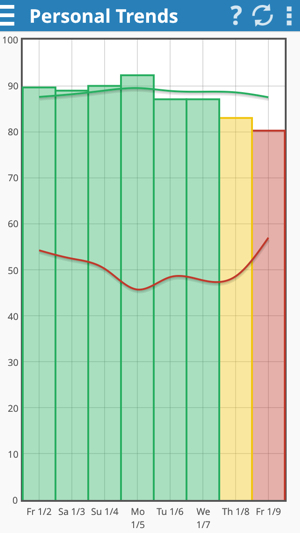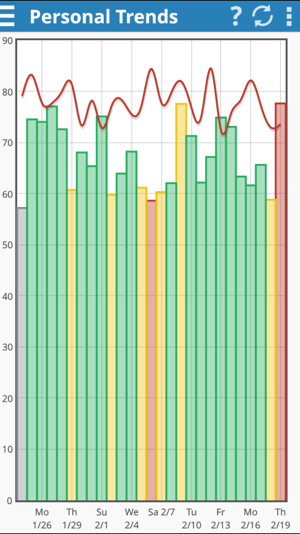Measuring Heart Rate Variability is Easy: Here's Why You Should
Written by Christopher Kelly
Oct. 6, 2015
Heart rate variability (HRV) as a simple way to measure readiness to train. It's also an ideal biomarker for tracking your workout progress, which allows you to avoid overtraining and running into low cortisol issues. Because of the benefits of HRV, I get everyone I work with—athlete or not—to take a daily reading. If you are not already using HRV, here’s why you should add this one habit to keep the finger on the pulse of your overall health and recovery.
What Is HRV?
Heart rate variability is the variation in the interval between heartbeats. HRV always goes up when someone is feeling better. The goal is usually to shoot for the highest HRV reading you can get over time, though you should expect to have a few dips when training hard.
There is no set range for HRV because it is unique to each individual. A fit athlete tends to have an HRV score above 70, and if it drops below 60, it’s often a warning sign. But, the best way to create your baseline for ongoing measurement is to track your HRV daily upon waking for a few weeks. You will begin to see patterns and ranges emerge, and these become your parameters.
I recommend Elite HRV for tracking your HRV because the app is simple to use, and all you need is a heart rate monitor strap. Here’s a quick 2-minute explainer about how to take your HRV with Elite HRV.
How Can I Use HRV for Training and Recovery?
I track my HRV daily as part of my training regimen and recovery. Here’s an example of how you can use HRV to track your training and better plan your recovery. See my daily HRV in the chart below. (Note: The green line is the rolling average, and the red line is my heart rate in BPM.)

On 1/4 and 1/5, I rested completely. Notice the increase in HRV. I rode seven out of the ten days prior to these two rest days. On 1/6, I performed a 20-minute time trial to set parameters for my plan for the new season. Unfortunately, my timing was awful because daughter was suffering from a cold on the day of the test. The stress of the hard ride lowered my immunity and made me sick. The type-A, hard-charging athlete in me wanted to push on, but the data clearly indicated otherwise.
Why Should You Measure Your HRV Daily?
As the example above demonstrates, HRV is like a traffic signal. Green is go. Orange is proceed with caution. Red is come to a complete stop.
When the readings are good, you’re in the green zone and are ready to train, can handle activities of daily life with ease and might even be in a better mood. If your goal is to decrease stress, then shoot for green as much as possible.
When your readings begin to drop a little, you enter the orange zone, which tells you to be more aware than usual. It could either be a warning sign that something might be going on in your body, or it could be a sign that your training is stimulating your body just enough to make progress, if it happens once or twice per week. This is a good thing if your goal is athletic performance.
If you hit the red zone, your HRV is telling you to stop and pay attention. This is where you do more digging to discover and address the cause. Continuing to push on may lead to overtraining.
HRV is a non-invasive and easy way check in with your body daily to find out if anything is amiss BEFORE it becomes a big problem. When the HRV reading is lower than normal, you should reconsider whether to drag yourself into the gym for fat loss and improved athletic performance. You might be doing more harm than good. When your HRV gives you the green light to train or tackle a big project, then go for it.
How Can You Optimise Your HRV?
Now that you’re convinced of the benefits of HRV, what can you do to improve your HRV. These are the main factors you can focus on right now improve.
- Diet - Eat a real foods diet that is tailored to your goals and athletic performance. The Whole30 program is a great place to start.
- Lifestyle - You cannot live a stress-free life, but you can avoid unnecessary lifestyle stressors. Do a lifestyle assessment to find out where you can say “no” and simplify your lifestyle to focus on your most important goals. Improve your resilience through guided meditation.
- Exercise - HRV is one piece of evidence to help you plan your daily activity level and your training. When it comes to exercise, more is not always better. If your HRV indicates that you might need to slow down or take a day off, consider taking a day off or going for a lighter workout. It’s not a standalone measurement, so go ahead and train if you’re feeling great even with a low HRV score.
- Sleep - Get a solid eight hours of uninterrupted, dreamy sleep. Do what you must to get high-quality sleep, especially on the nights after you train hard.
When The Obvious Isn’t Enough
Though those factors will give you the best improvements in HRV, there could be other hidden factors affecting your HRV. Here’s one example. After working with Clay for six months, he made significant health improvements using a combination of diet, lifestyle, exercise and supplements. Even though he felt better, Clay couldn't help wondering what else might be possible, especially since his HRV continued to lag in the low 50s. Further investigation in the form of blood testing revealed elevated levels of the neurotoxin mercury, almost certainly from old amalgam fillings. As a result, Clay decided to get the amalgam fillings removed. This chart (below) shows Clay's HRV in the days immediately following the extraction of the fillings. Notice that his HRV skyrocketed while his stress levels plummeted. Coincidence? Maybe, but Clay had never seen a reading in the 90s before.

HRV and autoimmunity
This final example belongs to a friend suffering from the autoimmune disease Hashimoto's thyroiditis. The diet and lifestyle hacks listed above do a great job of managing the disease, but it's not perfect.

Red and yellow days correlate 100% with days that I feel crappy
With These Results, Why Is HRV Still so Controversial?
HRV as a standard measurement for training is still controversial. Old school coaches say that “HRV is bunk.” They claim that you don’t need a computer program to tell you if you should train. In my functional medicine practice, I specialise in working with athletes and successful business men and women, and I know that every one of them is a Type A, who will push beyond their own limits. Those types DO need an objective computer program to tell them whether or not they are recovered enough to train again.
Originally, scientists believed the low-frequency component of HRV originated from the sympathetic nervous system (flight or fight) and the high-frequency from the parasympathetic (rest and relax). I have a suspicion that it's a bit more complicated than that, but still, it's interesting to compare the day-to-day changes in these biomarkers. Becoming aware and in tune with your body is an extremely valuable lesson.
Stop Guessing. Start Quantifying.
It’s difficult to get people, especially high performers, to qualify how they feel, so here’s a way to quantify it. Getting started is easy. Just download the Elite HRV app and start tracking your HRV first thing every morning.
Wondering why your HRV is chronically low? It might be a red flag that warrants further investigation. Book a free consultation with me and I'll help you figure it out.
References
- Reduced Heart Rate Variability and Mortality Risk in an Elderly Cohort
- Resistance exercise training improves heart rate variability in women with fibromyalgia
- Heart rate variability, trait anxiety, and perceived stress among physically fit men and women
- The LF/HF ratio does not accurately measure cardiac sympatho-vagal balance
Register for instant access to your FREE 15-page book, What We Eat
© 2013-2025 nourishbalancethrive